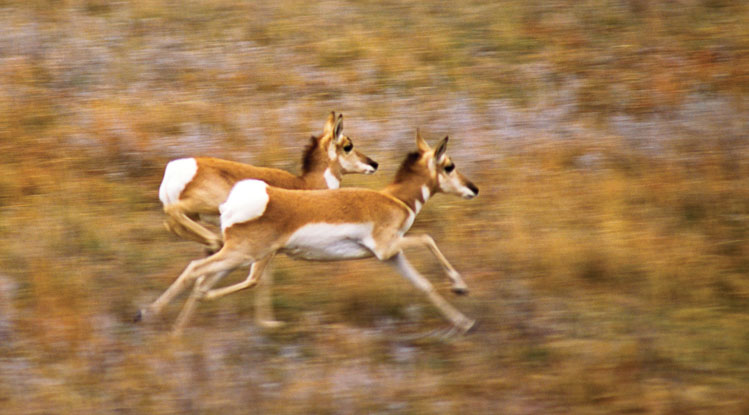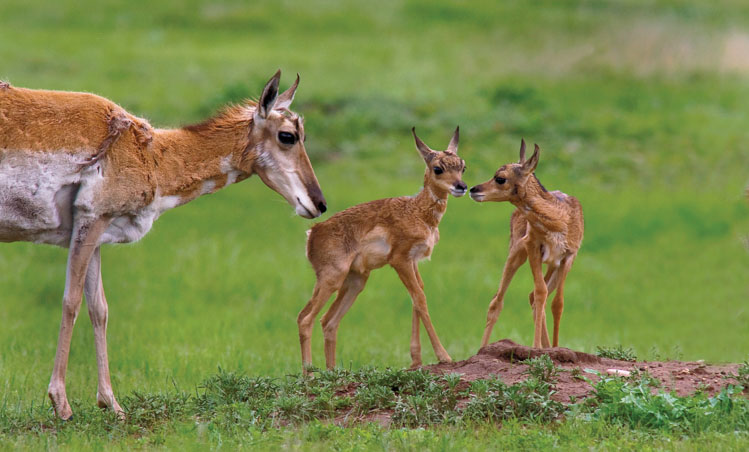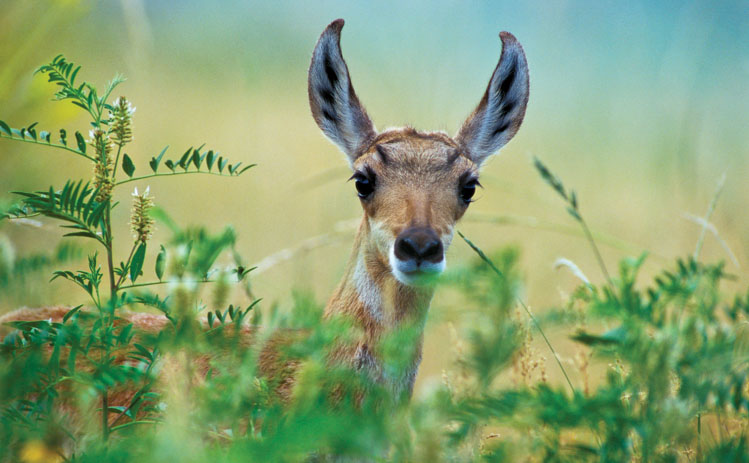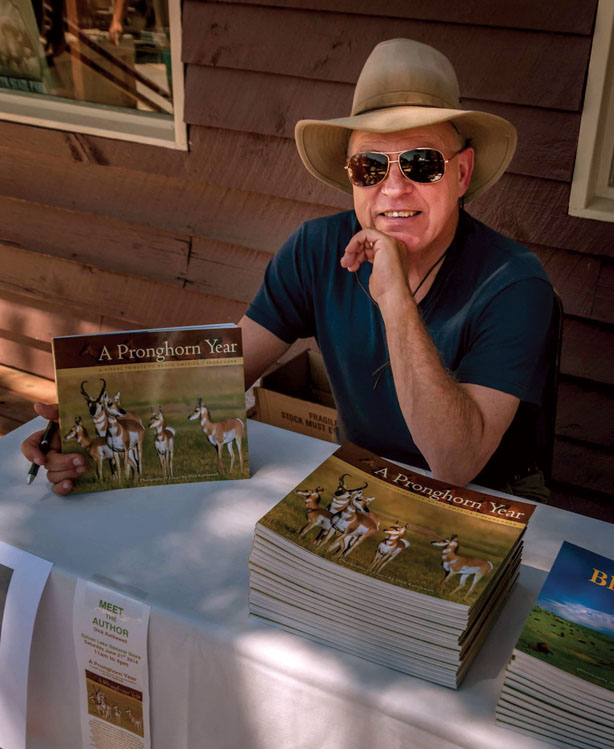By Paul Higbee
Photography by Dick Kettlewell
 Pronghorns are swift, hitting speeds between 60 and 65 mph when they run across the West River prairie.
Pronghorns are swift, hitting speeds between 60 and 65 mph when they run across the West River prairie.
PRONGHORNS, THE SLEEK and beautiful creatures that have the run of big sections of South Dakota prairie, are the fastest land animals in North America. They can hit speeds of 60 to 65 miles per hour.
Many of us learned that fact in elementary school before we knew the animal’s true name. For generations, Americans called pronghorns antelopes — a misnomer hard to overcome partly because of Daniel Kelley and Brewster Higley’s classic song, “Home on the Range.” It describes a Great Plains landscape where “the deer and the antelope play.” In fact, our South Dakota animals are not only geographically distant from true African savannah antelope, but completely distinct biologically. (No South Dakotan, though, will admonish you for using the term “antelope.”)
Biology has endowed pronghorns not only with strength and agility that translates to their terrific speed, but arguably the most remarkable eyes of any North American mammal. Their eyeballs are the size of an elephant’s. A pronghorn’s vision can be compared to ours when we’re equipped with a set of 8 x 50 binoculars.
Hot Springs wildlife photographer Dick Kettlewell has witnessed how that keen eyesight can prompt group action. “Sometimes I’ll be photographing a group of them and I’ll notice them stop and look at something in the distance,” he says. “And so I’ll look and look, but when I finally see what they see, they’ve run into the next county.”
Pronghorn eyes, adds Kettlewell, bulge almost like fish eyes and can see wide degrees of landscape. And there’s more.
 Pronghorn does are skilled at hiding their babies and defending them from natural predators such as coyotes.
Pronghorn does are skilled at hiding their babies and defending them from natural predators such as coyotes.
“They have those wonderful eyelashes,” Kettlewell says. “Especially the fawns. I call them Elizabeth Taylor eyelashes.”
Unseen is a big brain. Pronghorns are smart and able to learn. For example, conventional wisdom in the West long held that pronghorns couldn’t jump barbed wire fences. But Kettlewell thinks more are leaping fences in recent years, because the species has learned how.
“They probably prefer crawling under fences because their legs are made for running, not jumping,” Kettlewell says. “They could always jump over creek beds as they ran, but fences were something new when they appeared just 130 or 140 years ago in the West. That’s a very short time when you’re looking at the evolution of a species.”
The evolution of the pronghorn over the past few thousand years is an incredible story, one that made them perhaps the quintessential plains animal (only bison aficionados are likely to challenge that). Species of Asian goats made their way across the Ice Age land bridge and migrated as far south as the Florida peninsula, Mexico and maybe even Central America. But they apparently thrived best on the Great Plains, and it was from here the modern pronghorn emerged.
They made their way into the mythology of plains Native peoples, from creation stories to accounts of other creatures foolish enough to challenge them to races. According to those myths, wagering on those races is how pronghorns acquired such a vast amount of prairie grasslands. Natives also hunted pronghorns, sometimes shooting them and sometimes driving them over steep embankments on horseback.
Despite that history, Lewis and Clark had no knowledge of pronghorns until their journey into the West in 1804. They first spotted them along the Missouri River, somewhere downstream from where the Niobrara flows into it, south of present-day South Dakota. Members of Lewis and Clark’s Corps of Discovery, as they navigated the Missouri up through the middle of our future state, saw big herds on both sides of the river. They managed to shoot some and prepared two for mounting so that President Thomas Jefferson could take a look.
“Lewis and Clark called them antelope because they knew of the animals in Africa,” Kettlewell says. “You can’t blame them. The colors are similar.”
That was 217 years ago. Outsiders passing through South Dakota today are also often baffled by pronghorns. “They’re not especially well known outside our region,” Kettlewell says. “Travelers often think they’re some kind of deer.”
 A pronghorn’s eyes are as big as an elephants and accentuated by “Elizabeth Taylor” lashes.
A pronghorn’s eyes are as big as an elephants and accentuated by “Elizabeth Taylor” lashes.
Few people have done more than Dick Kettlewell to help the public learn about this under-the-radar animal. He paraphrases Henry David Thoreau in describing himself as “a self-appointed inspector” of Great Plains and Black Hills wildlife. Kettlewell’s pronghorn photography (as well as photos of most every other Northern Plains wild creature) have been featured in books, magazines and online resources. He takes photos by knowing what their behavior is likely to be in any given season, and then blending into the habitat with them.
He grew up living on three continents. When it was time for college, he selected a school near the center of the North American continent — Nebraska’s Chadron State College. A few weeks into his freshman year in 1964, Kettlewell and some buddies drove an hour north and, he recalls, “that was the first time I saw the Black Hills, elk and pronghorns. I kind of put the Black Hills in my pocket that trip, thinking I might want to come back there to live.”
First, though, Kettlewell worked as a photojournalist in Texas and New Mexico. He learned techniques for capturing speedsters — human athletes — on film as he covered sports. In 1995 he moved north and worked a dozen years for the Rapid City Journal. His “Spring Creek Chronicles,” a series of outdoor photo essays for the Journal, won both fans and awards.
Kettlewell loved all Black Hills prairie landscapes and wildlife but found pronghorns hard to top. “I like to show the motion in their legs,” he says, “especially when doing pan shots — moving the camera with them as they run — so that the background is blurred.”
Photographing those big-eyed fawns led Kettlewell to learn something else about pronghorn biology. Does, except for their first pregnancies, usually produce multiple births. That’s important because for all their speed, pronghorns — especially fawns — get picked off by natural enemies.
“Coyotes come after fawns, and I’ve seen eagles do the same,” says Bob Speirs, a Spearfish High School language arts teacher who also works as a hunting guide. “Fawns are smaller than jackrabbits, and eagles can pick them up.”
That’s not to suggest pronghorns aren’t tough. “Unbelievably tough,” Speirs adds. “I see them on windswept hillsides in winter because that’s where they’ll get to the grass.” And in mid-September, mating season, bucks are tough on one another. “That’s when they act like goats, ramming each other. Sometimes bucks are injured brutally,” Speirs says.
But nothing brutalizes entire herds like bitter winters that seem to come once or twice a decade: mid-1980s, late-1990s, three in a row from 2008 to 2011, and Winter Storm Atlas in 2013. Come spring, South Dakotans look across the emptied plains and wonder if pronghorns will bounce back, but they always do, and usually surprisingly fast.
 Photographer Dick Kettlewell collected images of pronghorns in all seasons for his book A Pronghorn Year, released in 2014.
Photographer Dick Kettlewell collected images of pronghorns in all seasons for his book A Pronghorn Year, released in 2014.
Unregulated hunting and disease in the West nearly drove pronghorns to extinction in the late 1800s and early 1900s. In 1911, the South Dakota legislature outlawed harvesting pronghorns, and shortly after, early wildlife management efforts (including a Harding County preserve) met success in bringing the animals back. By the mid-1920s, about 700 grazed the state’s grasslands, mostly west of the Missouri. Devastating as the Dust Bowl years of the 1930s were for people, they proved beneficial to pronghorns in the long run because they drove lots of farmers off the land and opened up wider habitats. The 1930s, in fact, saw state-regulated hunting put to work to maintain healthy herds.
Today nearly 50,000 pronghorns live in South Dakota, according to state Game, Fish and Parks pronghorn management documents. They’re mostly found in the northwest, on tribal lands and all along the South Dakota-Wyoming border. Open, rolling and untilled lands make prime habitats.
While out-of-state travelers in general may not be attuned to pronghorns, that’s not the case with those inclined to hunt. They love the challenge of quick, small targets (an adult buck may weigh only 120 pounds). Speirs is noticing increasing popularity in archery pronghorn hunting.
There is a payoff. Pronghorn meat, says Speirs, is sweet and tender. Many people who say they don’t like wild game make an exception for pronghorn.
Kettlewell, meanwhile, still picks up new knowledge about the species while in the field with his camera. “I think most of us have the impression that mother pronghorns protect their young by leading predators away from their prey,” he says. “But I have also watched a pronghorn doe defend, protect and kick a coyote to keep fawns safe.”
One day Kettlewell dropped into a ravine where a fawn lay hidden in deep grass. A coyote descended from the other side of the ravine. Suddenly, Kettlewell saw the mother appear and “sprint right into the coyote and roll him over. Then she kicked him with her front legs and he went running. This doe was right behind him, biting, and she chased him out of the ravine. She was gone for 20 or 30 seconds and came back to the fawn.”
The three- or four-week-old fawn stood, oblivious to its close call, and followed its mother out of the ravine. The doe had won the battle, ensuring survival for the youngest of a species that has learned to thrive on the plains of South Dakota.
Editor’s Note: This story is revised from the January/February 2021 issue of South Dakota Magazine. To order a copy or to subscribe, call (800) 456-5117.






![Air gun 101: The differences between .177 & .22 – Which jobs they do best ? [Infographic]](https://airgunmaniac.com/wp-content/uploads/2020/09/g44-218x150.jpg)








































